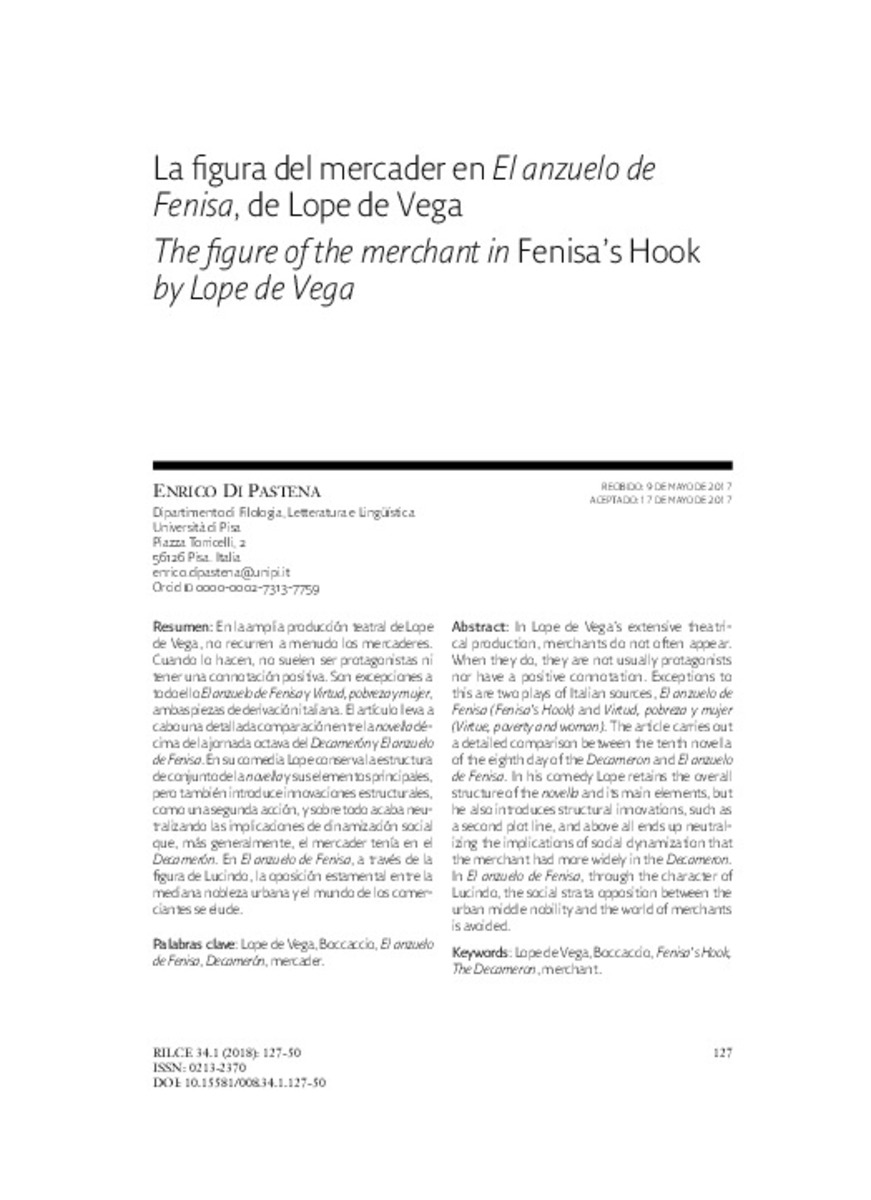Full metadata record
| DC Field | Value | Language |
|---|---|---|
| dc.creator | Di-Pastena, E. (Enrico) | - |
| dc.date.accessioned | 2018-06-11T10:33:09Z | - |
| dc.date.available | 2018-06-11T10:33:09Z | - |
| dc.date.issued | 2018 | - |
| dc.identifier.citation | Di-Pastena, E. (Enrico). "La figura del mercader en El anzuelo de Fenisa, de Lope de Vega". Rilce. Revista de Filología Hispánica. 34 (1), 2018, 127 - 50 | es |
| dc.identifier.issn | 0213-2370 | - |
| dc.identifier.uri | https://hdl.handle.net/10171/53134 | - |
| dc.description.abstract | En la amplia producción teatral de Lope de Vega, no recurren a menudo los mercaderes. Cuando lo hacen, no suelen ser protagonistas ni tener una connotación positiva. Son excepciones a todo ello El anzuelo de Fenisa y Virtud, pobreza y mujer, ambas piezas de derivación italiana. El artículo lleva a cabo una detallada comparación entre la novella décima de la jornada octava del Decamerón y El anzuelo de Fenisa. En su comedia Lope conserva la estructura de conjunto de la novella y sus elementos principales, pero también introduce innovaciones estructurales, como una segunda acción, y sobre todo acaba neutralizando las implicaciones de dinamización social que, más generalmente, el mercader tenía en el Decamerón. En El anzuelo de Fenisa, a través de la figura de Lucindo, la oposición estamental entre la mediana nobleza urbana y el mundo de los comerciantes se elude. | - |
| dc.description.abstract | In Lope de Vega’s extensive theatrical production, merchants do not often appear. When they do, they are not usually protagonists nor have a positive connotation. Exceptions to this are two plays of Italian sources, El anzuelo de Fenisa (Fenisa’s Hook) and Virtud, pobreza y mujer (Virtue, poverty and woman). The article carries out a detailed comparison between the tenth novella of the eighth day of the Decameron and El anzuelo de Fenisa>/i>. In his comedy Lope retains the overall structure of the novella and its main elements, but he also introduces structural innovations, such as a second plot line, and above all ends up neutralizing the implications of social dynamization that the merchant had more widely in the Decameron. In El anzuelo de Fenisa, through the character of Lucindo, the social strata opposition between the urban middle nobility and the world of merchants is avoided. | - |
| dc.language.iso | spa | - |
| dc.publisher | Servicio de Publicaciones de la Universidad de Navarra | - |
| dc.rights | info:eu-repo/semantics/openAccess | - |
| dc.subject | Lope de Vega | - |
| dc.subject | Boccaccio | - |
| dc.subject | El anzuelo de Fenisa | - |
| dc.subject | Decamerón | - |
| dc.subject | mercader | - |
| dc.subject | Lope de Vega | - |
| dc.subject | Boccaccio | - |
| dc.subject | Fenisa’s Hook | - |
| dc.subject | The Decameron | - |
| dc.subject | merchant | - |
| dc.title | La figura del mercader en El anzuelo de Fenisa, de Lope de Vega | - |
| dc.title.alternative | The figure of the merchant in Fenisa’s Hook by Lope de Vega | - |
| dc.type | info:eu-repo/semantics/article | - |
| dc.identifier.doi | 10.15581/008.34.1.127-50 | es_ES |
| dadun.citation.endingPage | 50 | - |
| dadun.citation.number | 1 | - |
| dadun.citation.publicationName | Rilce. Revista de Filología Hispánica | - |
| dadun.citation.startingPage | 127 | - |
| dadun.citation.volume | 34 | - |
| dc.date.updated | 2018-06-11T10:33:09Z | - |
| dc.description.version | Peer Reviewed | - |
Files in This Item:
Statistics and impact
Items in Dadun are protected by copyright, with all rights reserved, unless otherwise indicated.






